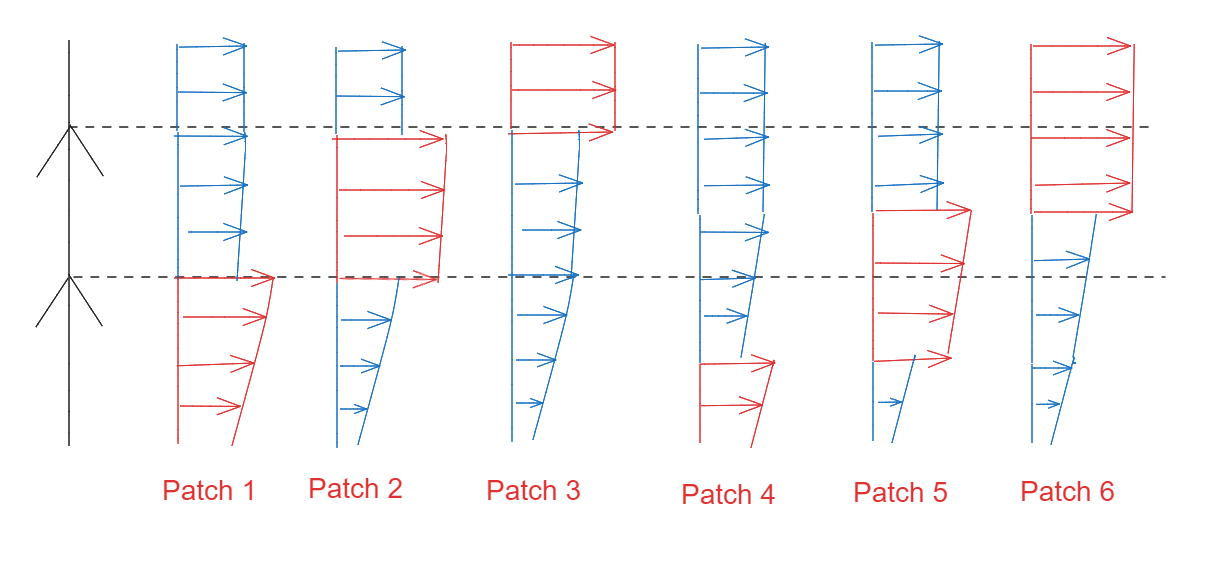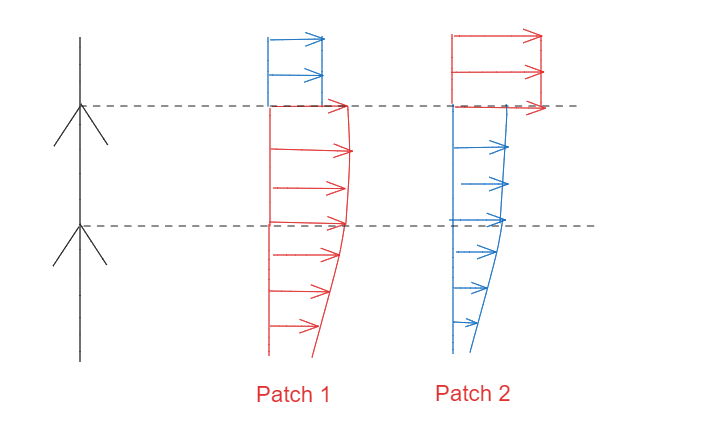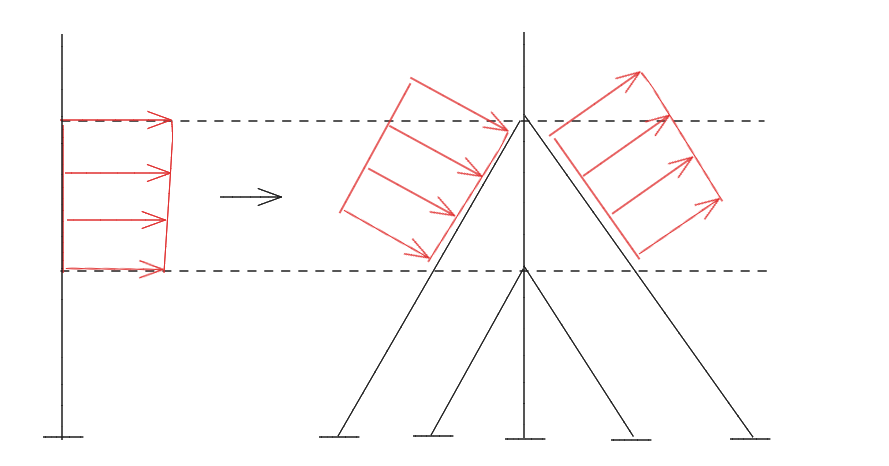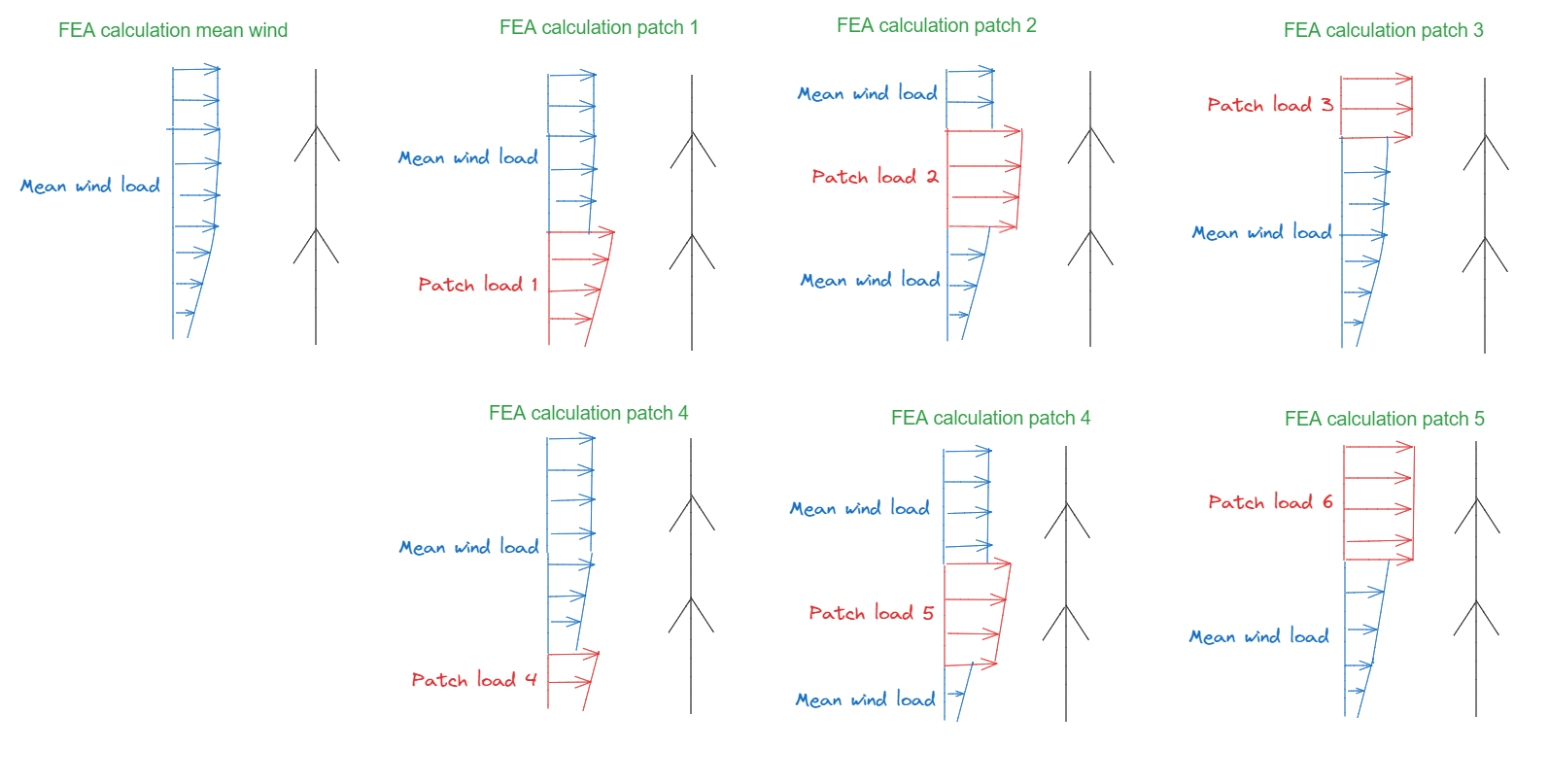Eurocode states that “the maximum forces used in the design of components in a guyed mast should be calculated with due allowance for the response to wind turbulence.” This involves a complex process of calculating the dynamic response through static analysis using a patch loading approach. To streamline this process, we have implemented these Eurocode guidelines in our app, automating the calculations and visualizations needed for accurate design.
In this blogpost, we will explain the patch loading approach as per Eurocode, demonstrate an example calculation, and show how Shapemaker simplifies this intricate procedure.
Patch Loading Approach: Key Steps
The patch loading approach consists of three key steps:
- Identifying Vertical Patches
- Application of Loading
- Determining the load effects
Identifying Vertical Patches
The guyed mast is divided into vertical patches depending on the guy wire levels and spans. Patches are concentrated at each guy wire level and each span. For masts up to 50 meters without a cantilever at the top, only one patch case needs to be considered. For masts up to 50 meters with a cantilever, two cases need to be considered, see (4) B.4.3.2.2 EN 1993-3-1:2006.
Scenario 1:
A guyed mast exceeding 50 meters in height with two levels of guy wires results in six patches.
The picture below illustrates the patches.

Scenario 2:
A guyed mast below 50 meters with a cantilevered top results in two patches. See picture below:

Application of Loading
Once the patches are identified, loading them accurately is essential. The patches are loaded with a patch load, representing the peak/gust wind pressure. In addition to the mean wind load, formula (B.22), the patch load from formula (B.24) is applied over the patch.


When loading the guyed wires, chapter B.4.3.2.3 of the Eurocode is needed. It requires adjusting the loading direction to be normal to each guy wire within the plane containing the guy and the wind. See the picture below for an illustration of the loading direction from one patch on the guyed wires:

Determining the Load Effects
The load effect from each patch needs to be calculated. Since a non-linear FEA calculation is necessary for a guyed mast, the load effect from each patch is more cumbersome to calculate.
To calculate the load effect from one patch:
- First, a “FEA calculation with patch + mean wind load” needs to be analyzed.
- Then a “FEA calculation with mean wind load” needs to be analyzed.
- Third, the load effect of the “FEA calculation with patch + mean wind load” needs to be subtracted by the load effect of “FEA calculation with mean wind load”
Then you got the load effect from one patch, in Eurocode called SPLi.
A root mean square sum needs to be calculated to determine the total load effect of all the patch loads. In Eurocode, Sp. See equation B.26.

The total load effect, which will be used in the design of the components of the guyed mast, is determined by the load effect of the patch loads combined with the load effect from the mean wind load. See formula B.27. The sign is used to produce the most severe effect of fluctuating load Sp.
STM = SM ± Sp (B.27)
Example calculation
Conditions
- Guyed mast taller than 50 meters
- Two levels of guy wires
- -> 6 patches need to be considered
To cover one load combination representing one set of partial factors, 7 non-linear FEA calculations with different loading needs to be calculated.
The picture below illustrates the different FEA calculations representing the patches and mean wind loading.

The normal force in one member from the FEA calculations are following:
NMean = 5.2 [kN] (FEA calculation mean wind)
NPatch1 = 7.3 [kN] (FEA calculation patch 1)
NPatch2 = 4.8 [kN] (FEA calculation patch 2)
NPatch3 = -3.2 [kN] (FEA calculation patch 3)
NPatch4 = 3.1 [kN] (FEA calculation patch 4)
NPatch5 = -6.4 [kN] (FEA calculation patch 5)
NPatch6 = 3.0 [kN] (FEA calculation patch 6)
The load effect SPLi for each patch is calculated as follows:
SPL1 = 7.3 - 5.2 = 2.1 [kN]
SPL2 = 4.8 - 5.2 = -0.4 [kN]
SPL3 = -3.2 - 5.2 = -8.4 [kN]
SPL4 = 3.1 - 5.2 = -2.1 [kN]
SPL5 = -6.4 - 5.2 = -11.6 [kN]
SPL6 = 3.0 - 5.2 = -2.2 [kN]
The total load effect Sp is calculated like this:
Sp = square_root( SPL12 + SPL22 + SPL32 + SPL42 + SPL52 + SPL62) = 14.8 [kN]
Then the total load effect is calculated like this:
STM = SM ± Sp = 5.2 ± 14.8 = -9.6 and 20.0 [kN]
Conclusion
This example shows the internal force load effect for one member with one load combination. To strictly follow Eurocode, this process needs to be repeated for all internal forces, reactions, displacements, multiple wind directions, and different design situations, resulting in potentially thousands or millions of calculations.
Automating the Process with Shapemaker
Shapemaker automates this entire process, handling multiple wind directions, various sets of partial factors, and all necessary calculations. Our app allows you to visualize the loading in our FEA-viewer, ensuring patches are correctly placed, loads are accurate, and directions are correct.
Check out Shapemaker to streamline your guyed mast design process, ensuring compliance with Eurocode while saving time and effort.





